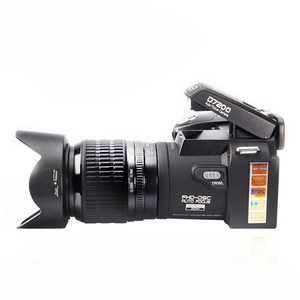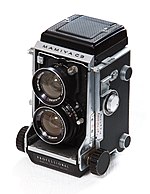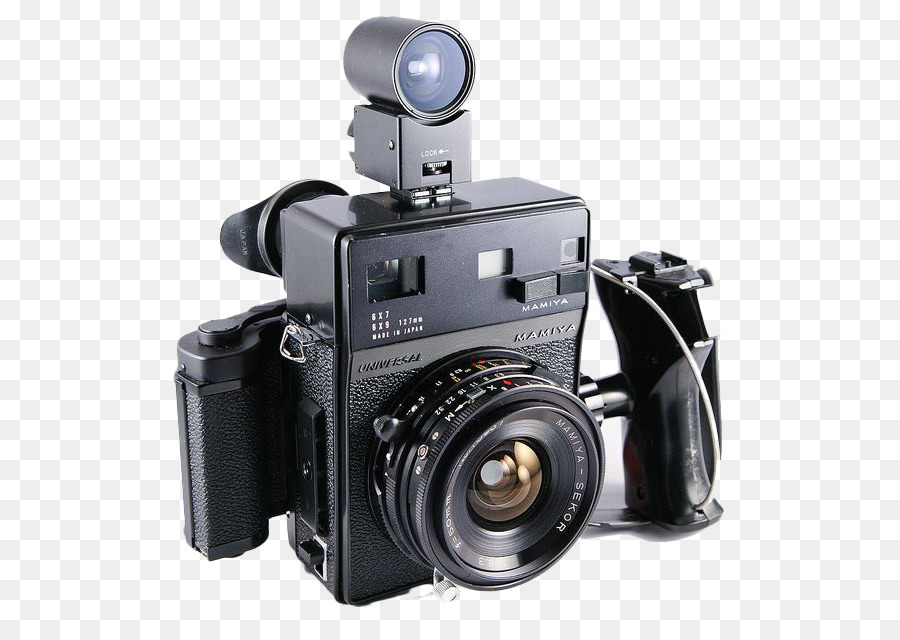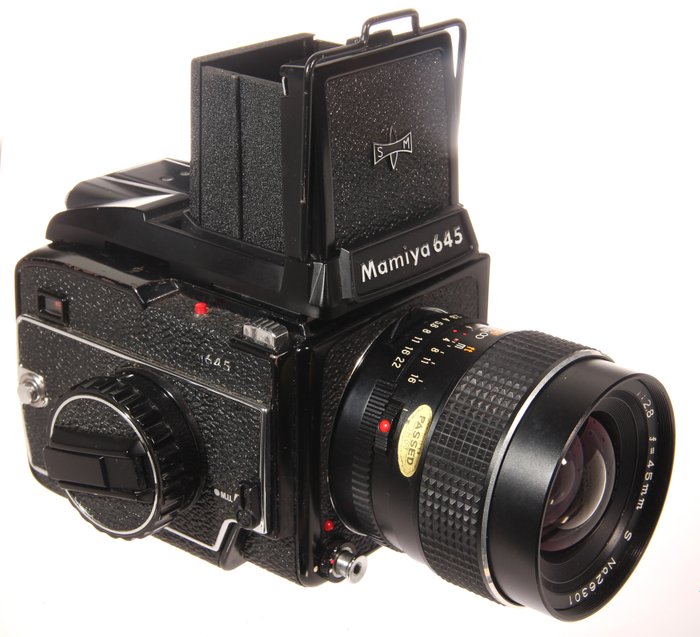

ماميا
 |
|
| الشركة المصنعة للكاميرا والعدسة | |
| صناعة | التصوير والتصوير الرقمي |
| تأسست | مايو 1940 |
| مقر |
طوكيو
، اليابان
|
|
الأشخاص الرئيسيين
|
سييتشي ماميا ، مؤسس |
| منتجات | الكاميرات والبصريات وغيرها من المنتجات |
|
عدد الموظفين
|
200 |
| الأبوين | المرحلة الأولى |
| موقع الكتروني | ماميا اليابان ماميا ليف |

حققت ماميا شهرة في الأصل لكاميراتها السينمائية متوسطة الحجم المحترفة مثل Mamiya Six وسلسلة Mamiya Press . وقد طورت لاحقًا سلسلة RB67 العاملة في الصناعة ، و RZ67 ، والانعكاس المزدوج العدسات Mamiya C-series ، التي يستخدمها المصورون الهواة والمحترفون المتقدمون.
العديد من نماذج ماميا خلال العقود الستة الماضية [ متى؟ ] أصبحت عناصر جامعي. أقدم كاميرا Mamiya Six متوسطة الحجم قابلة للطي ، وكاميرا Mamiya-Sekor 1000DTL مقاس 35 مم ، وخفيفة الوزن Mamiya NC1000 مقاس 35 مم ، وسلسلة C متوسطة الحجم مقاس 6 × 6 سم من الكاميرات المزدوجة ذات العدسة المزدوجة (TLR) ذات العدسة القابلة للتبديل ، و الكاميرات الصحفية من سلسلة Super / Universal ذات قيمة عالية. قامت Mamiya أيضًا بتصنيع أحدث الموديلات في خط أوميغا من الكاميرات ذات التنسيق المتوسط.
دخلت ماميا أسواق الأعمال الأخرى بمرور الوقت عن طريق شراء شركات أخرى. [1] حتى عام 2000 ، كانت تصنع معدات الصيد مثل قضبان الصيد وبكرات الصيد . في عام 2006 ، قامت شركة Mamiya Op Co.، Ltd.، Inc. بنقل الكاميرا والأعمال البصرية إلى Mamiya Digital Imaging Co.، Ltd. الشركة الأصلية ، التي تعمل في مجال Mamiya-OP ، لا تزال موجودة وتعمل على إنشاء مجموعة متنوعة من الصناعات منتجات الالكترونيات. كما تصنع نوادي الجولف وأعمدة نوادي الجولف وقبضاتها ، وكرات الجولف من خلال شركاتها التابعة كاسكو و USTMamiya. [2]
في عام 2009 ، اشترت المرحلة الأولى ، وهي شركة مصنعة للكاميرات الرقمية متوسطة الحجم من الدنمارك ، حصة كبيرة في ماميا. في عام 2012 ، جمعت المرحلة الأولى بين Mamiya وشركة فرعية أخرى ، Leaf Imaging ، أنشأت علامة تجارية جديدة ماميا ليف في جميع أنحاء العالم لدمج خطوط إنتاج الشركتين في عرض واحد كامل لنظام الكاميرات الرقمية. تقدم إعادة العلامة التجارية تطويرًا مبسطًا للمنتجات وإنشاء قاعدة مبيعات ودعم للعملاء أكثر كفاءة.
135 فيلم
بدأت ماميا بتصنيع كاميرات 135 فيلم في عام 1949 ، مع إدخال كاميرات 135 نقطة للتصوير والتصوير المدمجة في وقت لاحق. سلسلة ماميا -35 الممتازة لكاميرات محدد المدى أعقبتها ماميا بريزما SLR في عام 1961 و Mamiya TL / DTL في منتصف إلى أواخر الستينيات. كانت SX و XTL و NC1000 نماذج أخرى من كاميرات SLR من 135 فيلمًا قدمتها Mamiya. كانت سلسلة Z واحدة من آخر تصميمات SLR لـ 135 فيلمًا في Mamiya. كان نموذج ZE الأصلي للمبتدئين هو فتحة الأولوية – فقط SLR ؛ وأضاف ZE-2 التعرض اليدوي ؛ أضافت ZE-X أولوية الغالق ووضع التشغيل التلقائي الكامل للبرنامج ، و (مع فلاش مخصص وعدسة من سلسلة EF) ، وتعريض فلاش لأولوية التركيز). في هذه النماذج ، لم يكن لحلقة الفتحة اتصال مباشر بالحجاب الحاجز ، مما سمح لجسم الكاميرا بتجاوز الفتحة المحددة ، ويمكن للعدسات توصيل كمية كبيرة من المعلومات إلى جسم الكاميرا عبر جهات الاتصال الكهربائية على الحامل.
تم تقديم Mamiya ZM ، الذي تم تقديمه في عام 1982 ، بشكل أساسي نسخة متقدمة من ZE-2 ، مع بعض ميزات ZE-X. كانت آخر كاميرا ماميا 135 فيلم تم إنتاجها. كان لديها تحكم تلقائي في أولوية فتحة العدسة ، استنادًا إلى قراءات TTL المرجحة في المركز ، ونطاق سرعة غالق تلقائي من 4 ثوان إلى 1/1000 ، ونطاق يدوي من 2 ثانية إلى 1/1000. تشير الإشارات المرئية والصوتية إلى التعرض المفرط أو الناقص أو فشل البطارية المعلق أو اهتزاز الكاميرا المفرط. كما تم تحسين أوضاع القياس وإطلاق الغالق والموقت الذاتي وإعدادات الوقت اليدوي وبيئة عمل جسم الكاميرا.
في عام 1984 ، قدم أوساوا ، أحد الموزعين الرئيسيين في ماميا ، طلبًا مقابل المعادل الياباني للإفلاس ، وبعد فترة وجيزة ، أوقفت ماميا إنتاج 135 فيلمًا من الكاميرات للتركيز على السوق الاحترافية متوسطة الحجم.
تنسيق متوسط
قامت Mamiya بسلسلة من العدسات المزدوجة المنعكسة (TLR) مربعة الشكل طوال منتصف القرن العشرين. تم تطوير هذه الكاميرات في الكاميرات C (C2 ، C3 حتى C330s) التي تحتوي على عدسات قابلة للتبديل بالإضافة إلى تركيز منفاخ.
في عام 1970 ، قدمت ماميا RB67 6 × 7 سم منعكس العدسة الفردية (SLR). كاميرا RB67 ، وهي كاميرا كبيرة وثقيلة ومتوسطة الحجم مع منفاخ مقرب مدمج كانت مبتكرة وناجحة. استخدمت كاميرات SLR الاحترافية متوسطة الحجم السابقة تنسيق 6 × 6 سم المربّع الذي لا يتطلب تدوير الكاميرا للصور في اتجاه عمودي ، مع إشكالية مع الكاميرات الكبيرة والثقيلة عند تركيب حامل ثلاثي الأرجل. مثل Linhof Technika ، كان لدى RB67 ظهر دوار مما مكن من التقاط الصور إما في الاتجاه الأفقي أو الرأسي دون تدوير الكاميرا ، على حساب الوزن الإضافي والجزء الأكبر. سرعان ما أصبح RB67 يستخدم على نطاق واسع من قبل المصورين الاستوديو المحترفين. تم تقديم إطار 6×7 وحصل على براءة اختراع من قبل Linhof (56 × 72 مم) ووصف بأنه مثالي ، لأن السلبيات تتطلب القليل من الاقتصاص لتناسب الورق القياسي مقاس 10 × 8 بوصة. استخدمت Mamiya في الواقع 56 × 67 مم. عند مقارنة RB67 بكاميرات 135 كاملة الإطار هناك ما يسمى “عامل المحاصيل” من النصف. وهذا يعني أن الإطار القياسي 35 مم يحتوي على “نصف” قطر 67 (على الرغم من أن النسبة مختلفة) ولكن ربع المساحة. هذا يؤثر على البعد البؤري للعدسات بحيث تحصل على مجال رؤية مكافئ على كاميرا 35 مم تحتاج إلى نصف البعد البؤري. هناك تأثير مماثل على عمق مجال فتحة معينة ، لذا فإن 90 مم f1: 3.5 على RB67 يعادل استخدام 45 مم f1: 1.8 على إطار كامل 35 مم.
في عام 1975 ، بدأت ماميا في تقديم M645 ، وهي كاميرا تعيد استخدام إطار 1930s 6×4.5 سم ، مما يسمح لـ 15 لقطة على فيلم 120 لفة قياسي بأن تصبح أول كاميرا SLR MF تقدم حصريًا حجم التنسيق المعروف أيضًا باسم تنسيق 645.
تبع كاميرا RB67 كاميرا RZ67 6x7cm الأكثر تطورًا في عام 1982. وأسست هذه الكاميرات Mamiya كشركة مصنعة احترافية رئيسية للكاميرات متوسطة الحجم ، إلى جانب Hasselblad و Rollei و Bronica و Pentax .
في عام 1989 ، قدمت Mamiya كاميرات ماميا 6 و Mamiya 7 (6x6cm و 6x7cm ، على التوالي) ، وكاميرات مدمجة وهادئة تشتهر بجودة بصرية عالية للغاية لعدساتها.
في عام 1999 ، قدمت Mamiya كاميرا Mamiya 645AF ، وكاميرا SLR بإطار 6X4.5 مع عدسات قابلة للتبديل وظهور للأفلام ، وتركيز تلقائي وواقي موشور متكامل من شأنه أن يكون المنصة الأساسية لفيلم Mamiya 645AFD والكاميرات الخلفية الرقمية.
المنتجات الرقمية
قدمت Mamiya كاميرا Mamiya ZD ، التي كانت عبارة عن كاميرا متوسطة الحجم صغيرة الحجم ، في عام 2004. وبدلاً من أخذ شكل حل رقمي للظهر ، تم دمجها جميعًا في وحدة واحدة ، مثل الكاميرا مقاس 35 مم تقريبًا. تستخدم هذه الكاميرا عدسات ماميا 645AF وبدقة 22 ميجابكسل. كان للحل صعوبات فنية وتأخر. في الوقت نفسه ، أعلنت Mamiya أيضًا عن عودة ZD التي كانت لها نفس المواصفات ولكن كان من المقرر استخدامها مع Mamiya 645AFDII / AFDIII. تأخر ظهر ZD بشكل أكبر ، وبمجرد تقديمه ، كان قديمًا بالفعل.
في عام 2009 ، تم إصدار النسخ الرقمية الرقمية من سلسلة Mamiya M (M18 و M22 و M31) والتي تتميز جميعها بعدد كبير من وحدات البكسل مع CCD كبيرة وتوافق مع مجموعة Mamiya 645AFD وسلسلة RZ / RB (عبر محولات مصنوعة خصيصًا). جميع الظهر متوافقة مع كاميرات عرض 4×5 بوصة. في الربع الأخير من عام 2009 ، أصدرت Mamiya كاميرا Mamiya 645DF ، وهي أحدث نسخة رقمية فقط من سلسلة كاميرات AF بتنسيق 6×4.5 الشهيرة. يتميز Mamiya 645DF بالعديد من الميزات المحسنة بما في ذلك تأخير المرآة ، ونقص تأخر الغالق ، وتفضيل التركيز البؤري التلقائي مع أولوية السرعة أو الدقة ، والتوافق مع نطاق عدسة الغالق الورقي الجديد (Mamiya Sekor AF 80mm ، و 55mm ، و 110 mm D عدسات مع – مصاريع أوراق مبنية). مع إرفاق هذه العدسات ، يمكن تحقيق سرعات تزامن فلاش تصل إلى 1/1600 من الثانية ، على الرغم من أنه يمكن أيضًا برمجة الكاميرا لاستخدام مصراع المستوى البؤري حتى إذا تم إرفاق عدسة مصراع الورقة. شهد عام 2010 إطلاق 3 أنظمة Mamiya DM (نظام Mamiya DM33 ، يتكون من جسم كاميرا 645DF وظهر رقمي 33 ميجابيكسل ، ونظام Mamiya DM28 ، يتكون من جسم كاميرا 645 AF III و 28 ميجابيكسل خلفية رقمية ، ونظام Mamiya DM22 ، يتكون لهيئة كاميرا 645 AF III و 22 ميجابيكسل خلفية رقمية ، كما تم إطلاق شعار جديد وصفحة ويب. [3]
شركة ماميا أمريكا
المنتجات
6 × 4.5 سم
- للحصول على وصف مفصل لمنتجات ماميا 6 × 4.5 سم ، انظر ماميا 645
شكل 6 × 6 سم
تنسيق 6 × 7 سم / متوسط التنسيق الاحترافي
- RB67 Pro-SD – ميكانيكية 6 سم × 7 سم SLR كاميرا متوسطة الشكل
- RZ67 IID – كاميرا إلكترونية متوسطة الحجم مقاس 6 سم × 7 سم
- ماميا 7II – كاميرا إلكترونية 6 سم × 7 سم
أجسام الكاميرا:
-

RZ67 Pro I
-

RZ67 Pro II ، ليس هناك فرق خارجي كبير بين النماذج
شكل 35 مم
-

35 مم SLR ماميا زد
-

ماميا 135 هـ
-

Mamiya ZM
العدسات

Mamiya
Jump to navigation Jump to search
|
This article needs additional citations for verification. (August 2012) (Learn how and when to remove this template message)
|
 |
|
| Camera and lens manufacturer | |
| Industry | Digital imaging and photography |
| Founded | May 1940 |
| Headquarters |
Tokyo
, Japan
|
|
Key people
|
Seiichi Mamiya, founder |
| Products | Cameras, Optical and other products |
|
Number of employees
|
200 |
| Parent | Phase One |
| Website | Mamiya Japan Mamiya Leaf |
Mamiya Digital Imaging Co., Ltd. (Japanese: マミヤ・デジタル・イメージング 株式会社, Hepburn: Mamiya Dejitaru Imējingu Kabushiki-gaisha, IPA: [mamija deꜜʑitaɾɯ imeꜜːʑiŋɡɯ kabɯɕi̥ki ɡaꜜiɕa]) is a Japanese company that manufactures high-end cameras and other related photographic and optical equipment. With headquarters in Tokyo, it has two manufacturing plants and a workforce of over 200 people. The company was founded in May 1940 by camera designer Seiichi Mamiya (間宮精一) and financial backer Tsunejiro Sugawara.
History
Mamiya originally achieved fame for its professional medium-format film cameras such as the Mamiya Six and the Mamiya Press series. It later developed the industry workhorse RB67 series, the RZ67 and the twin-lens reflex Mamiya C-series, used by advanced amateur and professional photographers.
Many Mamiya models over the past six decades[when?] have become collectors’ items. The earliest Mamiya Six medium-format folding camera, the 35 mm Mamiya-Sekor 1000DTL, the lightweight 35 mm Mamiya NC1000, the 6×6 cm medium-format C series of interchangeable-lens twin-lens reflex (TLR) cameras, and the press cameras of the Super/Universal series are highly valued. Mamiya also manufactured the last models in the Omega line of medium format cameras.
Mamiya entered other business markets over time by purchasing other companies.[1] Until 2000, it made fishing equipment such as fishing rods and fishing reels. In 2006, the Mamiya Op Co., Ltd., Inc. transferred the camera and optical business to Mamiya Digital Imaging Co., Ltd. The original company, doing business as Mamiya-OP, continues to exist and makes a variety of industrial and electronics products. It also makes golf clubs, golf club shafts and grips, and golf balls through its subsidiaries Kasco and USTMamiya.[2]
In 2009, Phase One, a medium format digital camera back manufacturer from Denmark, purchased a major stake in Mamiya. In 2012, Phase One combined Mamiya and another subsidiary, Leaf Imaging, created a new, worldwide Mamiya Leaf brand to integrate both companies’ product lines into one complete medium-format digital camera system offering. The re-branding offers a streamlined product development and establishment of a more efficient customer sales and support base.
135 film
Mamiya started manufacturing 135-film cameras in 1949, with 135-film point-and-shoot compact cameras being introduced later. The excellent Mamiya-35 series of rangefinder cameras was followed by the Mamiya Prismat SLR in 1961 and the Mamiya TL/DTL in the mid-to-late 1960s. The SX, XTL and NC1000 were other 135-film SLR camera models introduced by Mamiya. One of Mamiya’s last 135-film SLR designs was the Z-series. The original entry-level ZE model was an aperture-priority-only SLR; the ZE-2 added manual exposure; the ZE-X added shutter priority and full program automated mode, and (with a dedicated flash and an EF-series lens) focus-priority flash exposure). In these models the aperture ring had no direct connection to the diaphragm, allowing the camera body to override the set aperture, and the lenses could communicate a considerable amount of information to the camera body via electrical contacts on the mount.
The Mamiya ZM, introduced in 1982, was essentially an advanced version of the ZE-2, with some of the features of the ZE-X. It was the last Mamiya 135-film camera produced. It had an aperture-priority automatic time control, based on center-weighted TTL readings, an automatic shutter-speed range from 4 seconds to 1/1000, and a manual range from 2 seconds to 1/1000. Visual and audio signals indicated over- or under-exposure, pending battery failure, or excessive camera shake. Metering modes, shutter release, self-timer, manual time settings and the ergonomics of the camera body were also improved.
In 1984 Osawa, one of Mamiya’s major distributors, filed for the Japanese equivalent of bankruptcy and, soon after, Mamiya discontinued 135-film camera production to focus on the medium-format professional market.
Medium format
Mamiya made a series of square format twin lens reflex (TLR) throughout the middle of the twentieth century. These were developed into the C cameras (C2, C3 through to C330s) which have interchangeable lenses as well as bellows focus.
In 1970, Mamiya introduced the RB67 6×7 cm professional single lens reflex (SLR). The RB67, a large, heavy, medium-format camera with built-in closeup bellows was innovative and successful. Previous medium-format professional SLR cameras used the square 6×6 cm format which did not require the camera to be rotated for photographs in portrait orientation, problematical with large and heavy cameras when tripod-mounted. Like the Linhof Technika the RB67 had a rotating back which enabled photographs to be taken in either landscape or portrait orientation without rotating the camera, at the expense of additional weight and bulk. The RB67 soon became widely used by professional studio photographers. The 6×7 frame had been introduced and patented by Linhof (56 x 72mm) and was described as being ideal, as the negatives required very little cropping to fit on standard 10″ x 8″ paper. Mamiya actually used 56 x 67mm. When comparing the RB67 to full frame 135 cameras there is a so-called “crop factor” of a half. That means the standard 35mm frame has “half” the diagonal of the 67 (though the ratio is different) but a quarter the area. This effects the focal length of lenses so that to get an equivalent field of view on a 35mm camera you need half the focal length. There is a similar effect on the depth of field of a particular aperture, so a 90mm f1:3.5 on the RB67 is equivalent to using a 45mm f1:1.8 on 35mm full frame.
In 1975 Mamiya started to offer the M645, a camera re-using the 1930s 6×4.5 cm frame, allowing 15 shots on a standard 120 roll film becoming the first SLR MF camera to offer exclusively that format size also known as the 645 format.
The RB67 was followed by the more advanced RZ67 6x7cm frame format camera in 1982. These cameras established Mamiya as a major medium-format professional camera manufacturer, together with Hasselblad, Rollei, Bronica and Pentax.
In 1989, Mamiya introduced the Mamiya 6 and Mamiya 7 (6x6cm and 6x7cm, respectively) rangefinder cameras, compact and quiet cameras which are reputed for the extremely high optical quality of their lenses.
In 1999, Mamiya presented the Mamiya 645AF, a 6X4.5 frame SLR camera with interchangeable lenses and film backs, auto focus and an integrated prism visor that would be the base platform for the Mamiya 645AFD film and digital back cameras.
Digital products
Mamiya introduced the Mamiya ZD, which was a compact medium-format camera, in 2004. Rather than taking the form of a digital back solution, it was all built into one unit, much like a 35mm camera. This camera utilized the Mamiya 645AF lenses and had a resolution of 22mp. The solution had technical difficulties and became delayed. At the same time, Mamiya also announced a ZD back which had the same specification but was intended to be used with the Mamiya 645AFDII / AFDIII. The ZD back was even more delayed and, once it was introduced, it was already outdated.
In 2009, the Mamiya M Series digital backs were released (M18, M22 and M31) all featuring high pixel counts with large CCDs and compatibility with the Mamiya 645AFD range and RZ/ RB series (via specially manufactured adapters). All the backs are compatible with 4×5 inch view cameras. In the final quarter of 2009, Mamiya released its Mamiya 645DF camera, the latest and digital-only version of the famed 6×4.5 format AF camera series. The Mamiya 645DF has many improved features including mirror-up delay, lack of shutter lag, AF preference with priority on speed or precision, and compatibility with the new leaf shutter lens range (Mamiya Sekor AF 80mm, 55mm and 110mm D lenses with in-built leaf shutters). With these lenses attached, flash synchronizations speeds of up to 1/1,600 of a second are achievable, although the camera can also be programmed to use the focal plane shutter even if a leaf shutter lens is attached. 2010 saw the release of 3 Mamiya DM Systems (Mamiya DM33 System, consisting of a 645DF camera body and 33MP digital back, the Mamiya DM28 System, consisting of a 645 AF III camera body and 28MP digital back, and the Mamiya DM22 System, consisting of a 645 AF III camera body and 22MP digital back. A new logo and webpage were also launched.[3]
Mamiya America Corporation
In the United States, the trademark for “Mamiya” is not owned by the original company in Japan but rather by a wholly separate entity called Mamiya America Corporation (“M.A.C.”). As such, All products that bear the name “Mamiya” are controlled by M.A.C. and has resulted in a considerable rise in retail pricing when comparing the same products to ones sold outside the United States. As of 2014 MAC group no longer manages the Mamiya brand in America, all sales, service and support was transferred to Phase One who already owned a large portion of Mamiya.
Products
6×4.5 cm format
- For a detailed description of 6×4.5cm Mamiya products, see Mamiya 645
6×6 cm format
- Mamiya 6 — electronic 6 cm × 6 cm rangefinder camera
6×7 cm format / Medium Format Professional
- RB67 Pro-SD — mechanical 6 cm × 7 cm SLR medium-format camera
- RZ67 IID — electronic 6 cm × 7 cm SLR medium-format camera
- Mamiya 7II — electronic 6 cm × 7 cm rangefinder camera
Camera bodies:
35mm format
Lenses
See also
References
- “マミヤ・オーピー | 会社情報” (in Japanese). マミヤ・オーピー. Retrieved 7 August 2012.
- “マミヤ・オーピー | 事業内容” (in Japanese). マミヤ・オーピー. Retrieved 7 August 2012.
- Shell, Bob (1992). Mamiya Medium Format Systems (Hove Pro Guides). United Kingdom: Hove Books. pp. 208pp ill. ISBN978-0-906447-76-5.
External links
| Wikimedia Commons has media related to Mamiya cameras. |
- Mamiya Leaf
- Mamiya Digital Imaging Co., Ltd. (Mamiya Japan)
- マミヤ・オーピー (Mamiya Op Co., Ltd.) separate electronic and golf products company








